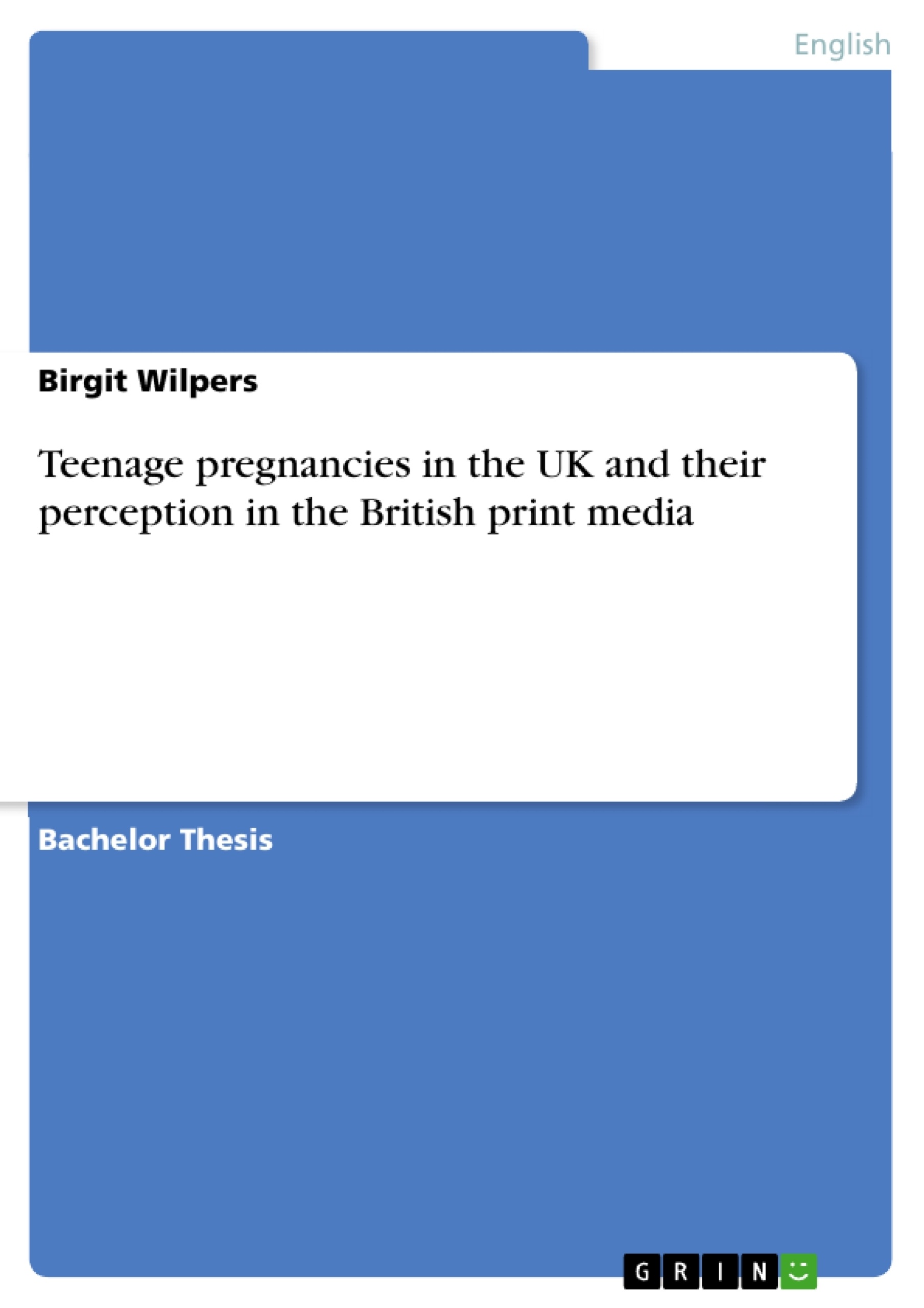One of the most controversial issues in the United Kingdom is the topic of teenage pregnancy. The United Kingdom's number of teenage mothers is the highest one in comparison to all other European states. This is an astonishing fact, the more so as European countries such as Spain, Italy or Poland with a traditionally more conservative background formerly based on Catholicism with its strict moral principles against extra-marital sex or use of contraceptives have lower rates of teenage parents. The issue of teenage pregnancies in the United Kingdom is, in general, regarded as one of the main and most urgent social problems in a modern society. Several political parties and governmental institutions have intended to tackle the problem by various campaigns, especially during the years of Labour Government. Likewise, the media provide their readers and viewers frequently with new figures, research results, comments or stories regarding this topic.
In this paper I want to examine the portrayal of teenage pregnancy and teenage mothers in the British print media with a focus on daily newspapers. For this purpose, the main part will be an analysis of a number of articles concerning this topic from the most popular newspapers. The subject matter deals with the question if there exists a relation between the coverage of the topic and the portrayal of the mothers and the transfer of ideology by the media. How does this particular representation contribute to the implementation of cultural values and the maintenance of existing power relations? Another interesting question to pose is whether the reporting on this topic has changed over the course of time, if it has increased during the last years and if there are certain political rationales behind a changing coverage.
Inhaltsverzeichnis (Table of Contents)
- INTRODUCTION
- 1. FACTS AND STATISTICS
- 1.1 TEENAGE PREGNANCY IN THE UNITED KINGDOM
- 1.1.2 SOCIAL BENEFITS AS AN ENTICEMENT FOR CHILDBEARING - A MYTH?
- 2. FACTORS RELATED TO TEENAGE PREGNANCY
- 2.1 VARIOUS FACTORS
- 2.2 SOCIAL BACKGROUND AND DEPRIVATION
- 2.2.1 CLASS
- 3. PRINT MEDIA
- 3.1 NEGATIVE EXAMPLES: THE BENEFIT MOTHER
- 3.2 POSITIVE EXAMPLES: THE OMNIPOTENT MOTHER
- 4. THE CREATION OF MEANING – CULTURE, REPRESENTATION AND DISCOURSE
- 4.1 STEREOTYPES AND THEIR FUNCTION
- 4.2 CREATION AND TRANSFER OF IDEOLOGY
- 4.3. POWER RELATIONS
- 4.4 POLITICAL BACKGROUND AND OBJECTIVES
- 5. IMPACTS ON TEENAGE MOTHERS - SELF-PERCEPTION
- 6. CONCLUSION
Zielsetzung und Themenschwerpunkte (Objectives and Key Themes)
This paper explores the portrayal of teenage pregnancy and teenage mothers in the British print media, particularly focusing on daily newspapers. It aims to investigate whether there is a correlation between media coverage, the depiction of teenage mothers, and the transfer of ideology by the media. The paper also examines how this representation contributes to cultural values and the maintenance of existing power relations. It delves into whether reporting on this topic has changed over time, particularly in recent years, and whether there are political motives behind shifts in coverage.
- The impact of media representation on the perception of teenage pregnancy
- The relationship between media portrayal and the transfer of ideology
- The role of stereotypes in shaping public opinion and power relations
- The self-perception of teenage mothers and their experiences with media coverage
- The influence of political factors on media reporting on teenage pregnancy
Zusammenfassung der Kapitel (Chapter Summaries)
The first chapter provides an overview of the current situation of teenage pregnancy in the UK, drawing on data from official sources such as the Office for National Statistics and international organizations like Unicef. It also discusses the trend of declining teenage pregnancy rates in the UK since 1998. The second chapter examines factors associated with teenage pregnancy, focusing on the role of social background, deprivation, and class in the UK. Chapter 3 analyzes newspaper articles, exploring the depiction of teenage mothers in the print media. It provides examples from various newspapers, including The Times, The Sun, and The Daily Mail, to demonstrate how these outlets construct images of teenage mothers. The fourth chapter delves into the broader meaning of these representations, drawing on theories from cultural studies to examine the function of stereotypes and their role in shaping ideology and discourse.
Schlüsselwörter (Keywords)
This paper focuses on the key terms and concepts of teenage pregnancy, media representation, ideology, stereotypes, power relations, and cultural studies. It examines the portrayal of teenage mothers in the British print media and its impact on public perception and societal attitudes.
- Quote paper
- Birgit Wilpers (Author), 2010, Teenage pregnancies in the UK and their perception in the British print media, Munich, GRIN Verlag, https://www.grin.com/document/163191



